Hello, and welcome to another dose of Friday Fresh mastery guidance for training providers.
In today’s edition of Friday Fresh, we look into the nuances of crafting an effective complaints procedure for training providers. A well-defined complaints procedure isn’t merely about managing grievances; it’s about distinguishing between different types of feedback and leveraging this understanding to build stronger relationships with your learners.
Rethinking Complaints: Clarity and Opportunity
- Defining a ‘Complaint’: It’s crucial to differentiate a complaint from other feedback forms. For example, a suggestion for content improvement isn’t a complaint but an opportunity for enhancement. Clearly stating what constitutes a complaint in your procedure helps streamline the process and encourages constructive feedback.
- Encouraging Content Suggestions: Establish a separate channel for content recommendations. This approach not only improves your course material but also fosters a collaborative relationship with your learners, showing that their input is valued and impactful.

Key Elements of an Effective Complaints Procedure
- Filing a Complaint: Outline a clear, accessible method for learners to file complaints. Whether it’s an online form, email, or a dedicated phone line, ensure the process is straightforward and user-friendly.
- Responsibility and Response: Assign a specific team or individual responsible for handling complaints. This ensures accountability and consistency in addressing grievances.
- Timeframes: Set and communicate realistic timeframes for acknowledging and resolving complaints. For instance, you might acknowledge receipt within 24 hours and aim to resolve issues within a set number of working days.
- Transparency and Tracking: Keep the complainant informed throughout the process. Use a tracking system to monitor the status of each complaint and ensure timely follow-ups.
- Outcome and Feedback: Once resolved, communicate the outcome to the complainant. Provide an opportunity for them to give feedback on the complaints process itself, enabling continuous improvement.
Record-Keeping: Maintain detailed records of all complaints and their resolutions. Regularly review these records to identify trends and areas for proactive improvement.

What Would Be The Final Outcome?
Your complaints procedure will be a document that states what happens, when, and who will be responsible for it. You may choose to have an ‘internal’ and an ‘external’ one, ak.a., your actual complaints procedure and an SOP (Standard Operating Procedure) so everyone is aware of what needs doing and by when if a complaint is filed in.
The ‘external’ document might end up looking like this:
“If you would like to file a complaint with us, please use the email complaints@company.com. Please include as much relevant information, as well as personal details that will allow us to identify your customer record on our system. Our complaints officer will acknowledge receipt of your complaint within 1 to 2 business days, and we will aim to resolve it as quickly as possible. Please note that we commit to resolving all complaints within 20 business days, and we might need to reach out to you for additional information a number of times throughout that period.”
You can continue the description with anything else you believe your customers need to know until you’re happy that you’ve communicated your methods clearly enough.

Final Thoughts
Your complaints procedure is more than a regulatory requirement; it’s a strategic tool for enhancing learner satisfaction and course quality. By clearly defining what a complaint is, encouraging constructive feedback, and implementing a transparent, accountable process, you not only resolve issues effectively but also demonstrate your commitment to excellence and continuous improvement.







